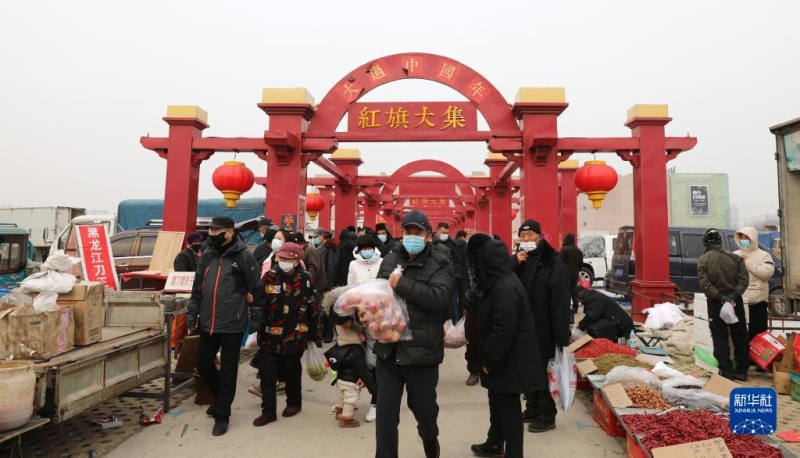In the past, Xiang Changyu used a basic cellphone to receive and make phone calls, but nowadays, with a smartphone, he is able to make use of WeChat, an instant messaging app, to sell his navel oranges, and to host livestreaming sessions to promote the specialty products of his hometown, Wangjiaqiao, located in a mountainous area in Zigui county, central China’s Hubei Province.
Wangjiaqiao has been connected with optic fiber cable and mobile internet is also accessible there.

Farmers shop for food at a market in Yingkou city, northeast China's Liaoning Province on Jan. 15, 2022. (Xinhua/Zhao Yong)
During the Spring Festival, Xiang cooked delicious and nutritious dishes for his friends and relatives, while his storage shelves were filled with dairy products, meat, eggs, fresh vegetables, and health supplements.
Xiang’s understanding of consumer goods has changed. “My clothes are fashionable and my shoes are comfortable. I expect my clothes and shoes to be warm and comfortable, as well as decent,” said Xiang.
Statistics indicated that last year, the per capita consumption expenditure of rural residents was 15,916 yuan, an actual increase was 15.3 percent. The per capita expenditure of rural residents on transportation and telecommunication was 2,132 yuan, up 15.8 percent from the previous year in nominal terms, and the per capita expenditure of rural residents on education, culture and recreation was 1,645 yuan, up 25.7 percent from the previous year in nominal terms.
Liu Yanxia is a resident from Houduanzhai village in north China’s Hebei Province. Last year, the farmers’ cooperative in her villager sold more than 7,000 tonnes of sweet potatoes.
“A box containing 4 kilograms of sweet potatoes was sold for 88 yuan. Thanks to the high quality of the potatoes and partially because 8 is a lucky number in China, the products sold well,” said Liu.
With the money she earned from the sweet potato business, Liu had a happy Lunar New Year. She used a housekeeping service for house cleaning before the festival, and purchased high-quality gifts for her relatives and friends.
Last year, the retail sales of consumer goods in rural China increased by 12.1 percent to reach 5.93 trillion yuan, while the per capita disposable income of rural residents was 18,931 yuan, up 10.5 percent.
“Thanks to favorable policies that have been constantly launched and implemented and the rapid development of rural industries, rural residents can afford to be willing to dare to spend,” said Li Guoxiang, a research fellow at the Rural Development Institute of the Chinese Academy of Social Sciences.
During the Spring Festival, Cao Jingping, a resident in Caobei village, Jiaxiang county, east China’s Shandong Province moved into a new house. “I bought the furniture from the market in the township and ordered express delivery services to the directly deliver the furniture to my doorstep,” said Cao.
“There are various markets in the township that sell all kinds of stuff. They offer big discounts, as well as repair and maintenance services, and I think their products and services are reliable,” Cao expressed, adding that he spent more than 30,000 yuan on a refrigerator, a big-screen television, a microwave, and an air fryer. He also said that there are several convenience shops and a 24-hour supermarket in his village, enabling residents to conveniently purchase fresh products.
“Based on the population distribution and people’s shopping habits, we upgraded comprehensive commerce and trade centers, improved shopping and recreational facilities, enhanced the ability of rural public facilities to serve, and knitted a tighter commercial network that covers both the county and the rural areas,” said Zhu Zhenhu, deputy director of the commerce bureau of Jiaxiang.
Township- and village-level regions account for 38 percent of China’s consumer market, having huge consumer potential, while improved rural infrastructure has provided firm support for unleashing the vitality of rural consumption.
Currently, all county-level regions and 98 percent of towns in China have access to express delivery services. Meanwhile, direct courier delivery was available in 80 percent of administrative villages in China by the end of last year.
Editor: Li Qiaoqiao